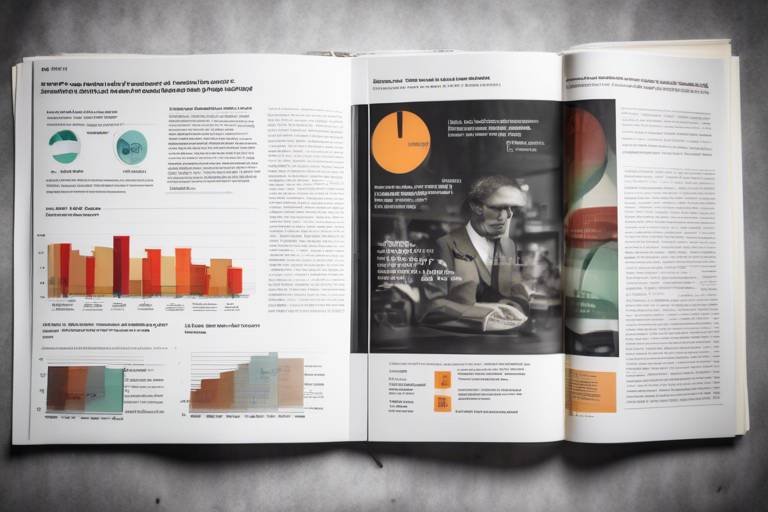Innovations in Longitudinal Studies - Tracking Changes Over Time
Longitudinal studies have become a cornerstone of research across various fields, from health and education to social sciences. They allow researchers to track changes and trends over time, providing invaluable insights that cross-sectional studies simply can't offer. But what does the future hold for these studies? With the rapid pace of technological advancements and methodological innovations, the landscape of longitudinal research is evolving at an unprecedented rate. In this article, we will delve into the latest innovations transforming longitudinal studies, exploring how they enhance our understanding of complex changes over time.
Longitudinal studies have a rich history, dating back to the early 20th century when researchers began to recognize the importance of studying subjects over extended periods. Initially, these studies were labor-intensive and often limited by the technology of the time. However, as methodologies evolved, so did the tools available for researchers. The emergence of computers in the 1960s and 1970s revolutionized data collection and analysis, allowing for more sophisticated statistical techniques and larger sample sizes. Today, we see a fusion of traditional methods with cutting-edge technologies, making longitudinal studies more accessible and insightful than ever before.
One of the most significant advancements in longitudinal studies is the integration of technology into data collection processes. Researchers now utilize a variety of tools that not only enhance participant engagement but also improve the accuracy of the data collected. Some of the most notable innovations include:
- Mobile Applications: These apps allow researchers to gather data in real-time, making it easier for participants to provide feedback and updates on their conditions.
- Wearable Devices: Technologies like smartwatches and fitness trackers enable continuous monitoring of health metrics, providing a wealth of data for analysis.
- Online Survey Platforms: These platforms facilitate reaching diverse populations, streamlining the data collection process significantly.
Mobile apps have transformed how researchers collect data, allowing for real-time updates and easier participant access. Imagine being able to gather information as events unfold—this immediacy enhances the richness of the data. Popular applications like SurveyMonkey and Qualtrics not only simplify the survey process but also engage participants through user-friendly interfaces. By making participation convenient, researchers can maintain higher response rates and gather more accurate data.
Wearable devices are another game-changer in longitudinal research. These gadgets provide continuous monitoring of health metrics, such as heart rate, physical activity, and sleep patterns. This constant flow of data allows researchers to observe changes over time with unprecedented detail. For instance, a study examining the effects of a new exercise regimen can track participants' physical activity levels daily, providing insights that would be impossible to capture through traditional methods.
Online survey tools have streamlined data collection, making it easier to reach diverse populations. They allow researchers to gather data from participants across geographical boundaries, which is particularly beneficial in longitudinal studies that require a broad sample. However, while these platforms offer numerous advantages, they also present challenges such as ensuring data security and managing participant privacy. Researchers must navigate these issues carefully to maintain the integrity of their studies.
With the influx of data from various sources, the need for innovative analysis techniques has never been greater. Researchers are employing advanced statistical methods and software tools to make sense of complex datasets. Techniques like mixed-effects models and growth curve analysis allow for a nuanced understanding of how variables interact over time. These methods enhance the interpretation of data, providing deeper insights into trends and patterns that can inform policy and practice.
Despite the exciting advancements, longitudinal studies are not without their challenges. Issues such as participant attrition, data management, and ethical considerations can complicate research efforts. Addressing these obstacles is crucial for the success of longitudinal studies.
One of the most significant challenges in longitudinal research is participant retention. High dropout rates can skew results and diminish the study's validity. Researchers can implement several strategies to minimize attrition, such as maintaining regular communication with participants, offering incentives, and making participation as convenient as possible. By fostering a sense of community and commitment, researchers can enhance engagement and retention throughout the study duration.
Longitudinal research often involves sensitive data, raising ethical concerns that must be addressed. Issues like informed consent and data privacy are paramount to maintaining participant trust. Researchers must ensure that participants are fully aware of how their data will be used and stored. Establishing clear protocols for data protection is essential to uphold ethical standards and promote a positive research environment.
Looking ahead, the future of longitudinal studies is bright, with emerging trends and potential technological innovations poised to reshape research methodologies. As artificial intelligence and machine learning continue to develop, we can expect more sophisticated data analysis techniques that will allow researchers to uncover insights previously thought unattainable. Moreover, as society becomes increasingly connected, the ability to gather and analyze data from diverse populations will only improve, paving the way for more comprehensive and impactful longitudinal studies.
- What are longitudinal studies? Longitudinal studies track the same subjects over time to observe changes and trends.
- Why are they important? They provide insights into how variables evolve, which is crucial for understanding long-term effects in various fields.
- What challenges do researchers face? Challenges include participant attrition, data management issues, and ethical considerations.
- How has technology impacted longitudinal studies? Technology has improved data collection methods, participant engagement, and data analysis techniques.
The Evolution of Longitudinal Studies
Longitudinal studies have a rich history that dates back several decades, providing researchers with a powerful tool to observe changes over time. Initially, these studies were primarily conducted through traditional methods such as in-person interviews and paper surveys. However, as the world evolved, so did the methodologies employed in longitudinal research. The journey of longitudinal studies reflects the broader evolution of research practices, adapting to the needs of society and advancements in technology.
In the early days, longitudinal studies were often limited by the resources available, which restricted the scope and scale of research. Researchers relied heavily on face-to-face interactions, which, while effective, were time-consuming and often resulted in small sample sizes. As the demand for more comprehensive data grew, researchers began to explore innovative ways to gather information. This led to the incorporation of new technologies and methodologies that have dramatically transformed the landscape of longitudinal studies.
One significant shift occurred with the advent of computer technology in the late 20th century. Researchers started to use computer-assisted data collection methods, which streamlined the process and allowed for the analysis of larger datasets. The introduction of statistical software further enhanced the ability to interpret complex data, enabling researchers to draw more nuanced conclusions about trends and changes over time.
Today, longitudinal studies are not just limited to academic research; they play a crucial role in various fields, including health, education, and social sciences. The integration of technology has made it possible to track participants over extended periods, providing invaluable insights into behavioral changes and outcomes. For instance, researchers can now observe how lifestyle changes impact health over time, leading to more effective interventions and policies.
As we look to the future, the evolution of longitudinal studies is likely to continue at a rapid pace. The rise of big data, artificial intelligence, and machine learning will undoubtedly influence how researchers design and conduct longitudinal studies. These advancements promise to enhance the accuracy and depth of findings, ultimately contributing to a better understanding of the complexities of human behavior and societal changes.
In summary, the evolution of longitudinal studies reflects a dynamic interplay between research needs and technological advancements. From humble beginnings to a sophisticated approach that leverages modern technology, longitudinal studies have proven to be an essential component in understanding change over time. As we embrace new innovations, the potential for longitudinal research continues to expand, offering exciting possibilities for future discoveries.
Technological Advancements in Data Collection
The landscape of longitudinal studies has been dramatically transformed by technological advancements in data collection. Gone are the days when researchers relied solely on paper surveys and face-to-face interviews. Today, innovative tools and platforms have emerged that not only streamline the data collection process but also enhance participant engagement and data accuracy. This shift has paved the way for researchers to gather insights that were once thought to be unattainable.
One of the most significant breakthroughs in this area is the rise of mobile applications. These apps have revolutionized how researchers interact with participants, allowing for real-time data collection and updates. Imagine being able to gather data on a participant's mood or health status as it happens, rather than relying on retrospective reporting. This immediacy not only improves the quality of the data but also fosters a sense of involvement among participants, making them feel like active contributors to the research.
With the proliferation of smartphones, mobile applications have become a popular choice for longitudinal studies. These apps offer a user-friendly interface that encourages participants to engage more frequently. Notably, many applications now include features such as reminders and notifications, which help keep participants on track with their data submissions. Some popular mobile applications used in longitudinal research include:
- MyStudy: Designed for clinical trials, it allows for real-time data entry and monitoring.
- ResearchKit: An open-source framework that enables researchers to create their own apps for health-related research.
- Qualtrics: Provides customizable surveys that can be accessed via mobile devices, enhancing participant reach.
These applications not only facilitate data collection but also provide researchers with a wealth of information that can be analyzed in real-time, leading to quicker insights and more agile research methodologies.
Another groundbreaking advancement in data collection is the integration of wearable technology. Devices like smartwatches and fitness trackers continuously monitor various health metrics such as heart rate, physical activity, and sleep patterns. This continuous data stream is invaluable for longitudinal studies, as it offers a comprehensive view of changes over time without the need for participants to manually report their data. The richness of data collected through these devices not only enhances research findings but also improves participant compliance, as many individuals are already accustomed to wearing these devices in their daily lives.
In addition to mobile applications and wearables, online survey platforms have become a staple in longitudinal research. These platforms allow researchers to reach a broader audience, making it easier to collect data from diverse populations. Tools like SurveyMonkey and Google Forms enable researchers to create surveys that are not only visually appealing but also easy to navigate. However, while these platforms offer numerous benefits, they also present challenges, such as ensuring data security and maintaining participant engagement over time.
In conclusion, the advancements in technology have significantly enhanced the way data is collected in longitudinal studies. From mobile applications and wearable technology to online survey platforms, these tools have made it easier for researchers to gather accurate and timely data. As technology continues to evolve, we can expect even more innovative solutions that will further enrich our understanding of changes over time in various fields.
Q1: What are longitudinal studies?
A: Longitudinal studies are research methods that involve repeated observations of the same variables over a period of time, allowing researchers to track changes and developments.
Q2: How do mobile applications improve longitudinal research?
A: Mobile applications facilitate real-time data collection, enhance participant engagement, and provide immediate feedback, which improves the overall quality of the data collected.
Q3: What role do wearable devices play in longitudinal studies?
A: Wearable devices continuously monitor health metrics and provide rich data for analysis, making it easier for researchers to track changes over time without relying on self-reported data.
Q4: What are the challenges of using online survey platforms?
A: While online survey platforms can reach diverse populations, challenges include ensuring data security, maintaining participant engagement, and managing the quality of the data collected.
Mobile Applications for Data Gathering
In the digital age, mobile applications have become a game-changer for researchers conducting longitudinal studies. Gone are the days when data collection was a cumbersome process involving pen and paper or lengthy phone interviews. Now, researchers can gather data in real-time, directly from participants' smartphones, making the entire process not only more efficient but also significantly more engaging for the participants.
One of the most appealing aspects of mobile applications is their ability to facilitate real-time updates. Imagine a health study where participants can log their daily habits, mood swings, or physical activities at their convenience. This immediacy not only enhances the accuracy of the data collected but also helps in capturing fleeting moments that might be forgotten if recorded later. Furthermore, mobile apps often come equipped with reminders and notifications, nudging participants to engage with the study consistently, thus improving retention rates.
Popular applications like MyFitnessPal and SurveyMonkey have set the standard for how data can be collected effectively. These platforms allow researchers to design customized surveys and track participant responses over time. The integration of multimedia features—such as video and audio recording—enables researchers to gather richer data. For instance, a researcher studying mental health could ask participants to record short video diaries, providing insights that a simple questionnaire could never capture.
Moreover, the user-friendly interfaces of these applications ensure that even those who are not tech-savvy can participate without feeling overwhelmed. This inclusivity is crucial, especially in studies aiming to reach diverse populations. However, while the benefits are substantial, there are challenges to consider. For instance, researchers must ensure that the data collected via mobile apps is secure and that participants' privacy is protected. This is where ethical considerations come into play, necessitating robust measures to safeguard sensitive information.
In conclusion, mobile applications have revolutionized the way data is gathered in longitudinal studies. They offer a blend of convenience, efficiency, and engagement that traditional methods simply cannot match. As technology continues to evolve, we can expect even more innovative features that will further enhance the research process, making it easier to track changes over time and gain valuable insights into human behavior.
- What are mobile applications used for in longitudinal studies?
Mobile applications are used to collect data in real-time, allowing participants to log information conveniently, thus improving data accuracy and engagement. - How do mobile apps enhance participant engagement?
They provide reminders and notifications, making it easier for participants to remember to contribute to the study regularly. - Are there any privacy concerns with using mobile applications?
Yes, researchers must ensure that sensitive data is securely stored and that participants' privacy is protected to maintain trust.
Wearable Technology Integration
In recent years, the integration of wearable technology into longitudinal studies has opened up a new frontier for researchers. Imagine a world where data collection is not just a periodic event but a continuous stream of information flowing seamlessly from participants into research databases. This is the reality that wearable devices have created. By providing a means to monitor health metrics such as heart rate, physical activity, and sleep patterns in real-time, wearables enhance the richness of data available for analysis.
These devices, ranging from smartwatches to fitness trackers, enable researchers to gather longitudinal data with unprecedented accuracy and detail. For example, a study on physical activity can utilize wearables to track how a participant's activity levels change over weeks or months, providing insights that traditional methods simply cannot match. This continuous monitoring not only captures data but also encourages participants to engage more actively with the research process, knowing their contributions are being recorded in real-time.
Moreover, the data collected through these devices can be analyzed to identify trends and patterns over time. For instance, a participant's increasing physical activity levels might correlate with improvements in their overall health metrics, such as lower blood pressure or better sleep quality. This integration of wearable technology allows researchers to draw more nuanced conclusions about the relationships between lifestyle changes and health outcomes.
However, the incorporation of wearable technology in research is not without its challenges. Issues such as data privacy and participant compliance must be addressed. Researchers must ensure that participants are fully informed about how their data will be used and that they have the option to withdraw from the study at any time without penalty. Additionally, researchers need to consider the technological literacy of participants, as not everyone may be comfortable using these devices.
In conclusion, wearable technology is transforming longitudinal research by providing a wealth of real-time data that enhances our understanding of human behavior and health over time. As these technologies continue to evolve, they promise to deliver even more sophisticated insights, making them an invaluable tool for researchers aiming to track changes in various fields.
- What types of wearable devices are commonly used in research?
Common devices include smartwatches, fitness trackers, and health monitoring bands. - How do wearables improve participant engagement?
They allow real-time feedback and tracking, making participants feel more involved in the research process. - What are the privacy concerns associated with wearable technology?
Participants' data must be protected, and they should be informed about how their data will be used. - Can wearables be used in all types of longitudinal studies?
While they are particularly useful in health-related research, wearables can also be applied in studies related to physical activity, sleep patterns, and even mental health.
Online Survey Platforms
In the realm of longitudinal studies, have emerged as a game changer, simplifying the data collection process while enhancing accessibility and participant engagement. These platforms allow researchers to reach a broader audience, breaking geographical barriers that traditional methods often impose. Imagine being able to gather insights from participants across the globe with just a few clicks! This convenience is not just a luxury; it’s a necessity in today’s fast-paced research environment.
One of the most significant advantages of using online survey platforms is the ability to collect data in real-time. Researchers can monitor responses as they come in, allowing for immediate adjustments if necessary. For instance, if a particular question is causing confusion among participants, it can be rephrased or clarified on the spot. This level of flexibility is invaluable, especially in longitudinal studies where maintaining participant engagement over time is crucial.
Moreover, many online survey tools come equipped with advanced analytics features that make it easier to analyze data. Researchers can utilize built-in statistical tools to generate reports, visualize data trends, and even perform complex analyses without needing extensive statistical software. This integration of data collection and analysis not only saves time but also enhances the accuracy of the findings. Below is a comparison of some popular online survey platforms:
| Platform | Features | Pricing |
|---|---|---|
| SurveyMonkey | User-friendly interface, customizable templates, real-time analytics | Free tier available; paid plans start at $25/month |
| Qualtrics | Advanced analytics, multi-channel distribution, robust reporting | Custom pricing based on needs |
| Google Forms | Free to use, easy integration with Google Sheets, simple design | Free |
While the benefits are clear, there are also challenges associated with online surveys. One of the primary concerns is ensuring that the data collected is representative of the population being studied. Researchers must consider factors such as digital literacy and access to technology when designing their studies. Additionally, there’s the risk of survey fatigue, where participants may become overwhelmed by the frequency or length of surveys, leading to lower response rates.
To mitigate these challenges, researchers can employ strategies such as shortening survey lengths, offering incentives for participation, and ensuring that surveys are mobile-friendly. By doing so, they can enhance the overall participant experience and maintain high levels of engagement throughout the study.
In conclusion, online survey platforms are revolutionizing the way longitudinal studies are conducted. They offer unparalleled convenience, real-time data collection, and advanced analytical tools that empower researchers to derive meaningful insights. However, it is essential to remain mindful of the challenges and to implement best practices to ensure the integrity and effectiveness of the research process.
- What are online survey platforms?
Online survey platforms are web-based tools that allow researchers to create, distribute, and analyze surveys efficiently. - How do online surveys improve participant engagement?
They provide convenience, accessibility, and real-time feedback, making it easier for participants to engage with the study. - What challenges do researchers face with online surveys?
Challenges include ensuring representativeness, preventing survey fatigue, and addressing digital access issues.
Data Analysis Techniques
When it comes to longitudinal studies, the ability to analyze data effectively is paramount. The sheer volume of information collected over time can be overwhelming, but with the right , researchers can uncover valuable insights that drive important conclusions. One of the most exciting advancements in this field is the use of innovative statistical methods that allow for a deeper understanding of complex datasets.
Traditional statistical techniques often fall short when dealing with data that evolves over time. This is where methods like mixed-effects models and growth curve modeling come into play. These approaches enable researchers to account for both fixed and random effects, providing a more nuanced view of how variables interact over time. For instance, if you're studying the long-term effects of a new educational program on student performance, these models can help you understand not just the average outcomes, but also how individual students might differ in their responses.
Moreover, the integration of machine learning algorithms is transforming how longitudinal data is analyzed. These algorithms can identify patterns and trends that might be invisible to the naked eye. For example, clustering techniques can group participants based on similar trajectories in their health metrics, leading to more personalized interventions. As researchers continue to harness the power of machine learning, the potential for discovering new correlations within longitudinal data grows exponentially.
Another crucial aspect of data analysis in longitudinal studies is the use of software tools. Programs like R, SAS, and SPSS have become staples in the toolkit of researchers. These platforms offer a range of functionalities tailored for longitudinal data, including:
- Data visualization: Creating graphs and charts that reveal trends over time.
- Statistical testing: Conducting tests to determine the significance of findings.
- Data management: Handling large datasets efficiently to ensure accuracy.
To illustrate the impact of these techniques, consider the following table that summarizes some common data analysis methods used in longitudinal studies:
| Analysis Method | Description | Applications |
|---|---|---|
| Mixed-Effects Models | Accounts for both fixed and random effects in data. | Education, Health Outcomes |
| Growth Curve Modeling | Analyzes changes in variables over time. | Psychology, Social Sciences |
| Machine Learning Algorithms | Identifies patterns in large datasets. | Health Monitoring, Marketing |
In conclusion, as we delve deeper into the world of longitudinal studies, the importance of robust data analysis techniques cannot be overstated. They not only help in making sense of complex information but also pave the way for future research innovations. The combination of traditional methods with modern technology is a game changer, allowing researchers to explore new frontiers in understanding changes over time.
1. What are longitudinal studies?
Longitudinal studies are research designs that involve repeated observations of the same variables over a period of time, allowing researchers to track changes and developments.
2. Why are data analysis techniques important in longitudinal studies?
Data analysis techniques are crucial because they help researchers interpret complex datasets, uncover trends, and draw meaningful conclusions from the data collected over time.
3. How do mixed-effects models work?
Mixed-effects models consider both fixed effects (variables that are constant across individuals) and random effects (variables that vary between individuals), providing a comprehensive view of the data.
4. Can machine learning be used in longitudinal studies?
Yes, machine learning algorithms can analyze large datasets to identify patterns and trends, enhancing the depth and quality of insights drawn from longitudinal studies.
Challenges in Longitudinal Research
Longitudinal research, while immensely valuable, is not without its challenges. As researchers delve into the complexities of tracking changes over time, they often encounter a myriad of obstacles that can complicate their findings. One of the most significant issues is participant attrition. Over time, participants may drop out of the study for various reasons, such as moving away, losing interest, or experiencing life changes that make participation difficult. This can lead to biased results and limit the generalizability of the findings.
Another challenge is data management. As longitudinal studies typically span several years, researchers must handle vast amounts of data collected at multiple time points. This can lead to issues with data consistency, accuracy, and storage. Moreover, ensuring that the data is properly coded and organized for analysis is crucial yet often overwhelming.
Ethical considerations also pose a significant hurdle. Longitudinal studies frequently involve sensitive information, requiring strict adherence to ethical guidelines. Researchers must ensure that participants provide informed consent and that their data is kept confidential. This responsibility can be daunting, particularly when dealing with vulnerable populations.
To tackle these challenges, researchers are increasingly turning to innovative strategies. For instance, to address participant attrition, they might implement engagement techniques such as:
- Regular check-ins via mobile apps or emails to maintain participant interest.
- Offering incentives for continued participation, such as gift cards or access to exclusive content.
- Creating community forums where participants can share experiences and support each other.
In terms of data management, leveraging advanced software tools can streamline the process. Utilizing platforms that automate data collection and analysis can significantly reduce the burden on researchers and enhance data integrity.
Ethical considerations can be mitigated by establishing clear protocols for data handling and ensuring ongoing communication with participants about how their data will be used. Transparency is key to maintaining trust and encouraging continued participation.
In summary, while longitudinal research presents unique challenges, the adoption of innovative strategies and technologies can help researchers navigate these obstacles effectively. By addressing participant attrition, improving data management practices, and adhering to ethical standards, researchers can enhance the quality and reliability of their findings.
- What is participant attrition in longitudinal studies? Participant attrition refers to the loss of participants over time, which can affect the validity of the research results.
- How can researchers reduce participant dropout rates? Researchers can engage participants through regular communication, incentives, and creating supportive communities.
- What ethical considerations are involved in longitudinal research? Ethical considerations include obtaining informed consent, ensuring data privacy, and maintaining participant confidentiality.
- Why is data management crucial in longitudinal studies? Effective data management ensures the accuracy, consistency, and reliability of the information collected over time.
Addressing Participant Attrition
Participant attrition is one of the most significant challenges in longitudinal studies, often threatening the integrity and validity of research findings. Imagine embarking on a journey with a group of friends, only to have some drop off along the way. This is precisely what happens in research when participants leave the study prematurely. The reasons for attrition can vary widely—from personal circumstances to lack of motivation or even dissatisfaction with the study process. Understanding these factors is crucial for researchers aiming to maintain a robust sample size throughout the duration of their studies.
To mitigate participant attrition effectively, researchers can implement several strategies that focus on engagement and support. First and foremost, **communication** plays a pivotal role. Keeping participants informed about the study's progress and how their contributions are making a difference can foster a sense of belonging and commitment. Regular updates through emails or newsletters can make participants feel valued and remind them of the study's importance.
Another effective approach is to enhance the **participant experience**. This can include simplifying the data collection process, offering flexible scheduling for assessments, and ensuring that participation is as convenient as possible. For instance, using mobile applications or online platforms for surveys not only streamlines the process but also allows participants to engage at their own pace, reducing the likelihood of dropout due to inconvenience.
In addition, providing **incentives** can be a powerful motivator. Offering small rewards for participation, such as gift cards or entries into raffles, can encourage participants to remain engaged throughout the study. However, it’s essential to strike a balance; incentives should not overshadow the intrinsic motivation to contribute to meaningful research.
Moreover, researchers should consider the implementation of **support systems**. This could involve regular check-ins or follow-ups with participants to address any concerns or challenges they may be facing. Establishing a rapport can significantly enhance participant retention, as individuals are more likely to stay committed when they feel supported and understood.
Lastly, conducting preliminary research to understand the specific demographics of the participant pool can help tailor retention strategies. For example, if a study involves a younger demographic, utilizing social media platforms for communication and engagement can be more effective than traditional methods.
In summary, addressing participant attrition is not just about keeping numbers up; it's about fostering a community of engaged individuals who are invested in the research process. By focusing on communication, enhancing the participant experience, offering incentives, providing support, and understanding the participant demographic, researchers can significantly reduce attrition rates. This approach not only strengthens the study's findings but also contributes to a more comprehensive understanding of the phenomena being investigated.
- What is participant attrition? Participant attrition refers to the loss of study participants over time, which can impact the validity of longitudinal research.
- Why do participants drop out of studies? Reasons can include personal circumstances, lack of motivation, dissatisfaction with the study process, or changes in life situations.
- How can researchers minimize attrition? Strategies include maintaining communication, enhancing participant experience, providing incentives, and offering support systems.
- Are incentives effective in reducing attrition? Yes, incentives can motivate participants to stay engaged, but they should be balanced with intrinsic motivation.
- What role does communication play in participant retention? Effective communication keeps participants informed and engaged, fostering a sense of belonging and commitment to the study.
Ethical Considerations in Longitudinal Studies
When diving into the intricate world of longitudinal studies, one cannot overlook the significant ethical considerations that accompany this research methodology. These studies often span years, collecting a wealth of data from participants, which raises crucial questions about informed consent, data privacy, and the overall treatment of individuals involved. Researchers must tread carefully to ensure that they not only gather valuable insights but also respect the rights and dignity of their participants.
One of the most pressing ethical issues is the need for informed consent. Participants should fully understand what their involvement entails, including how their data will be used and the potential risks involved. It’s not just about getting a signature on a piece of paper; it’s about fostering a genuine understanding and trust. Researchers can achieve this by providing clear, concise information and encouraging participants to ask questions before they agree to join the study.
Moreover, the nature of longitudinal research often means that participants may change their minds about their involvement over time. Researchers must have provisions in place to allow participants to withdraw easily from the study without facing any repercussions. This flexibility is crucial in maintaining ethical integrity and participant trust.
Another critical aspect is data privacy. With the rise of digital data collection methods, safeguarding sensitive information has become more challenging yet essential. Researchers must implement robust security measures to protect participants’ data from unauthorized access. This includes using encryption, anonymizing data, and ensuring that only authorized personnel can access sensitive information. The ethical obligation to protect participant privacy extends beyond data collection; it also involves careful consideration of how data will be stored, shared, and ultimately disposed of.
Additionally, researchers must be aware of the potential for bias in longitudinal studies. The demographic makeup of participants can skew results, leading to conclusions that may not be applicable to broader populations. It's essential to strive for diversity in participant recruitment to ensure that findings are representative and can be generalized across different groups.
To summarize, the ethical landscape of longitudinal studies is complex and multifaceted. Here are some key considerations:
- Informed Consent: Ensure participants understand their role and the use of their data.
- Withdrawal Rights: Allow participants to exit the study at any time without penalty.
- Data Privacy: Implement strong security measures to protect sensitive information.
- Bias Awareness: Strive for diversity in participant recruitment to avoid skewed results.
As we move forward in this field, the commitment to ethical standards must remain at the forefront of longitudinal research. By prioritizing the well-being and rights of participants, researchers not only uphold ethical integrity but also enhance the credibility and reliability of their findings.
1. What is informed consent in longitudinal studies?
Informed consent is the process by which participants are fully educated about the study's purpose, procedures, risks, and benefits before agreeing to take part. It ensures that participants are making an informed decision.
2. How can researchers ensure data privacy?
Researchers can ensure data privacy by using encryption, anonymizing data, and restricting access to sensitive information to authorized personnel only.
3. What should participants know before joining a longitudinal study?
Participants should be informed about the study's goals, what their involvement entails, their right to withdraw, and how their data will be used and protected.
4. Why is diversity important in longitudinal studies?
Diversity is crucial because it helps ensure that the findings are representative of the larger population, making the results more applicable and valid across different demographics.
Future Directions in Longitudinal Research
As we look to the horizon of longitudinal research, it's clear that the landscape is evolving at a breathtaking pace. With the integration of advanced technologies and innovative methodologies, the future holds immense potential for enhancing our understanding of change over time. Imagine a world where researchers can gather data seamlessly, analyze it in real-time, and derive insights that were previously unimaginable. This is not just a dream; it's quickly becoming a reality.
One of the most exciting prospects is the ongoing development of artificial intelligence (AI) and machine learning algorithms. These technologies can sift through vast amounts of data, identifying patterns and trends that human analysts might overlook. For example, AI can help predict participant behavior based on historical data, allowing researchers to tailor their approaches and improve retention rates. This ability to personalize engagement strategies could be a game-changer in maintaining participant involvement throughout lengthy studies.
Moreover, the rise of big data analytics is transforming how we interpret longitudinal data. With tools that can handle complex datasets, researchers can uncover insights that were once hidden. Imagine being able to correlate health outcomes with socio-economic factors on a massive scale—this could lead to groundbreaking discoveries in public health and policy-making.
Another area ripe for innovation is the use of virtual and augmented reality (VR/AR). These technologies offer immersive experiences that can enhance participant engagement. For instance, researchers could create virtual environments that simulate real-life scenarios, allowing participants to navigate situations that would be difficult to replicate in traditional settings. This could provide richer, more nuanced data about human behavior and decision-making processes over time.
In addition to technological advances, the future of longitudinal studies will likely see a shift towards collaborative research models. By pooling resources and data across institutions and disciplines, researchers can create larger, more diverse datasets that lead to more robust findings. This collaborative approach not only enhances the credibility of the research but also fosters a sense of community among scientists, encouraging cross-pollination of ideas and methodologies.
Furthermore, as we embrace a more global perspective, the inclusion of diverse populations in longitudinal studies will become increasingly important. Researchers will need to consider cultural differences and how they impact data collection and interpretation. This means developing methodologies that are sensitive to the unique contexts of various populations, ensuring that findings are applicable and beneficial across different groups.
As we move forward, ethical considerations will remain at the forefront of longitudinal research. With the growing use of technology comes the responsibility to protect participant data and ensure informed consent. Researchers must prioritize transparency and trust, fostering an environment where participants feel secure in sharing their information.
In conclusion, the future of longitudinal research is poised for exciting transformations. By leveraging new technologies, embracing collaborative models, and prioritizing ethical standards, researchers can unlock new insights that will significantly enhance our understanding of changes over time. The question is, are we ready to embrace these changes and harness their potential?
- What are longitudinal studies? Longitudinal studies are research methods that involve repeated observations of the same variables over long periods, allowing researchers to track changes and developments over time.
- How do technological advancements impact longitudinal research? Technologies such as AI, wearable devices, and online survey platforms enhance data collection, participant engagement, and data analysis, leading to more accurate and comprehensive findings.
- What are the ethical considerations in longitudinal studies? Ethical considerations include ensuring informed consent, protecting participant privacy, and maintaining transparency in data usage.
- What is the significance of participant retention in longitudinal studies? High participant retention is crucial for the validity of longitudinal studies, as dropout can lead to biased results and limit the generalizability of findings.
Frequently Asked Questions
- What are longitudinal studies?
Longitudinal studies are research methods that involve repeated observations of the same variables over a period of time. They are essential for understanding how things change and develop, giving researchers insights into trends and patterns in various fields like health, education, and social sciences.
- How have technological advancements impacted longitudinal studies?
Technological advancements, such as mobile applications, wearable devices, and online survey platforms, have significantly improved data collection in longitudinal studies. These tools enhance participant engagement and data accuracy, allowing researchers to gather real-time information more effectively.
- What challenges do researchers face in longitudinal studies?
Researchers encounter several challenges in longitudinal studies, including participant attrition, data management issues, and ethical considerations. Addressing these challenges is crucial for maintaining the integrity of the research and ensuring valid outcomes.
- How can participant attrition be minimized?
To minimize participant attrition, researchers can implement strategies such as regular communication, offering incentives, and making participation as convenient as possible. Keeping participants engaged and informed helps maintain their commitment throughout the study.
- What ethical considerations are involved in longitudinal research?
Ethical considerations in longitudinal research include ensuring informed consent, protecting participant privacy, and maintaining data confidentiality. Researchers must be transparent about how data will be used and take steps to build and maintain trust with participants.
- What is the future of longitudinal studies?
The future of longitudinal studies looks promising with emerging trends such as the integration of artificial intelligence and big data analytics. These innovations could lead to more efficient methodologies and deeper insights into complex datasets, shaping how research is conducted in the coming years.



















